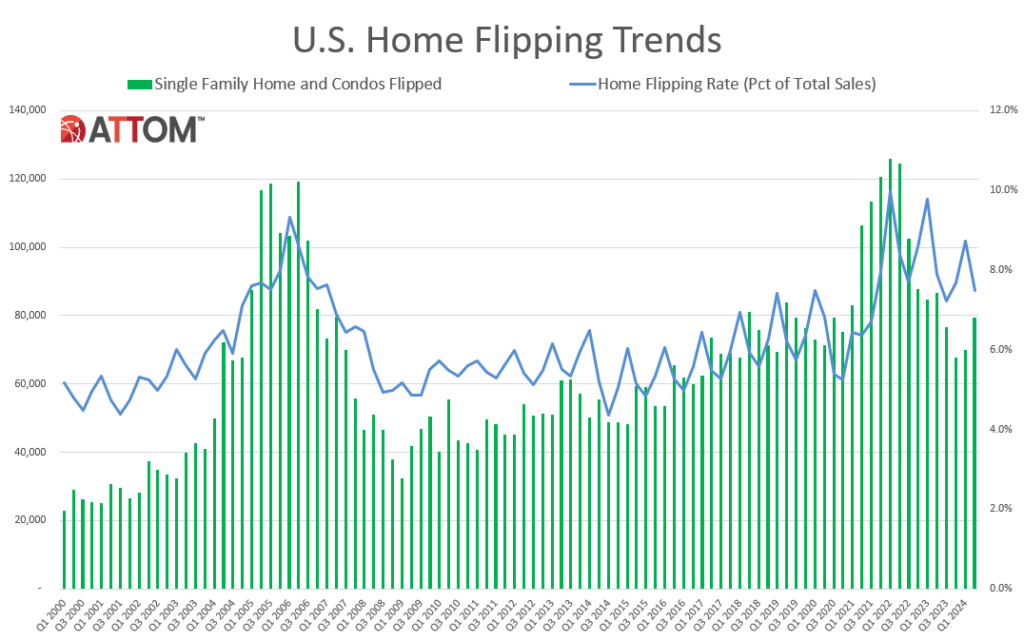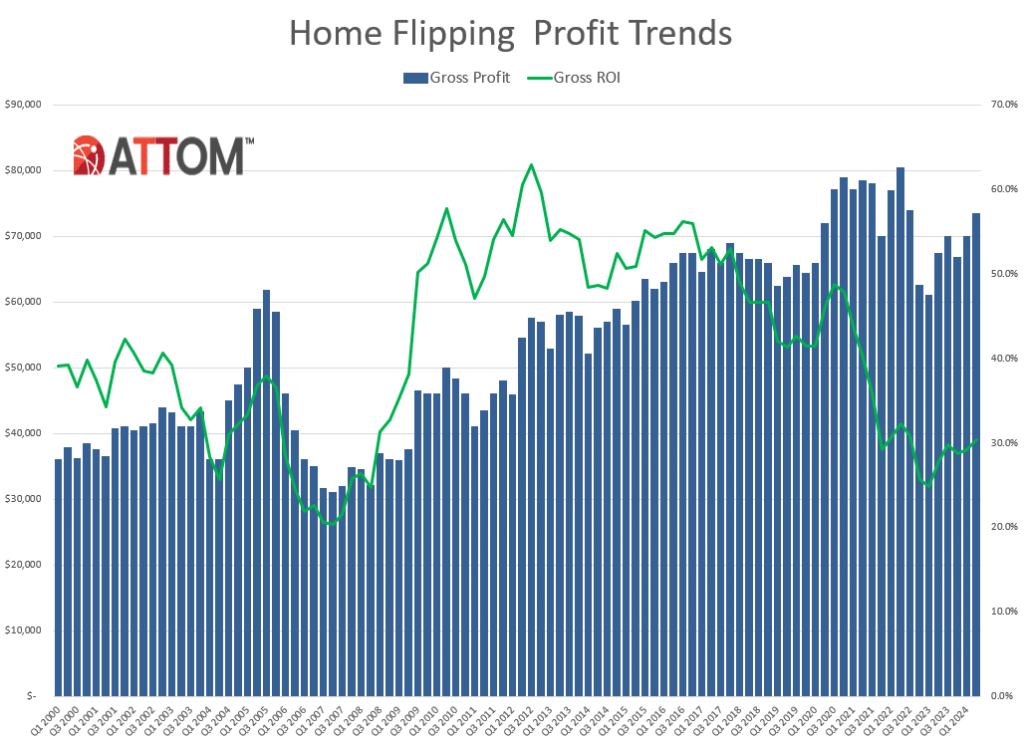ATTOM has released its second-quarter 2024 U.S. Home Flipping Report, showing that 79,540 single-family homes and condominiums in the U.S. were flipped over the period. Those transactions represented 7.5%, or one of every 13 home sales, nationwide during the months of April through June 2024.
The latest portion of flipped properties was down from 8.7% of all sales in the U.S. during Q1 of 2024. The flipping rate also was down slightly from 7.9% a year earlier.

And while the rate may have declined, home flipper profits ticked upward for investors who buy, renovate and quickly resell homes, and in Q2, investors typically earned a 30.4% profit nationwide before expenses on homes sold during the quarter, marking the fourth time in five quarters that margins increased following a six-year period of nearly continuous drop-offs. The typical profit margin on homes flipped during Q2—based on the difference between the median purchase and median resale price for home flips—remained approximately 25 percentage points below peaks hit in 2016. It also stayed within a range that could easily be wiped out by carrying costs that include renovation expenses, mortgage payments and property taxes, revealing anew the struggles home flippers are having in turning healthy profits.
But the return on investment (ROI) was up slightly from both Q1 of 2024, and from a low point over the past decade of about 25% in Q1 of last year. Gross profits on typical flips around the country, meanwhile, increased to about $73,500. That remained down from a high of almost $81,000 reached in 2022, but up from $70,000 in Q1of 2024, and more than $12,000 above last year’s low point.
“The Spring home-buying season of 2024 brought another sign of hope for home flippers that the rebound in fortunes that began for them last year was more than just a temporary thing,” said Rob Barber, CEO for ATTOM. “It’s not as if profits have shot through the roof and investors are riding a new wave of good times. Far from it, as they continue to struggle to benefit from the broader market boom. But the second-quarter numbers did show another step in the right direction.”
Gauging Flipping Regionally
Home flips as a portion of all home sales decreased from Q1 of 2024 to Q2 of 2024 in 159 of the 185 metropolitan statistical areas (MSAs) with enough data to analyze (85.9%). They declined annually in 115, or 62.2%, of those markets. Measured against the same peak buying period of 2023, most flipping rates declined less than one percentage point. Metro areas were included if they had a population of 200,000 or more and at least 50 home flips in Q2 of 2024.
Among the metro areas analyzed, the largest flipping rates during Q2 of 2024 were reported in:
- Warner Robins, Georgia (where flips comprised 20.7% of all home sales)
- Macon, Georgia (15.4%);
- Atlanta (13.4%);
- Columbus, Georgia (13.2%)
- Memphis (12.8%)

Ranking Historical Trends in Flipping
Aside from Atlanta and Memphis, the highest Q2 flipping rates among metro areas with a population of more than one million were reported in:
- Birmingham, Alabama (11.7%)
- Cleveland, OH (11%)
- Columbus, Ohio (10.7%)
The smallest rate of home flipping activity was reported in:
- Hilo, Hawaii (3.3%)
- Honolulu (3.5%)
- Seattle (4%)
- San Jose, California (4.1%)
- Portland, Oregon (4.2%)

Returns on Home Flips
The median $315,000 resale price of homes flipped nationwide in Q2 of 2024 generated a gross profit of $73,492 above the median investor purchase price of $241,508. That resulted in a typical 30.4% gross profit margin before expenses in Q2 of 2024, up about one point from 29.2% in Q1 of 2024, and up from 27.8% in Q2 of last year. But the latest nationwide figure still remained far beneath the 56.3% level reported in mid-2016, and from a more recent peak of 48.8% in 2020. Profit margins increased from Q1 to Q2 in 93 of the 185 metro areas analyzed (50.3%) and were up annually in 107 of those markets (57.8%).
Metro areas reporting the biggest year-over-year increases in typical profit margins during Q2 were in:
- Akron, Ohio (ROI up from 30.9% in Q2 of 2023 to 78.1% in Q2 of 2024)
- Cape Coral-Fort Myers, Florida (up from 13.8% to 56.4%)
- Springfield, Illinois (up from 34.5% to 75%)
- Gainesville, Florida (up from 30.2% to 65.3%)
- Spokane, Washington (up from 28.6% to 61.4%)
The largest raw profits on median-priced home flips in Q2, measured in dollars, were concentrated in areas of the West, South and Northeast regions, where resale prices mostly topped $400,000. Nine of the top 10 fell into that category, led by San Jose, CA (typical gross profit of $350,000 on a median resale value of $1.7 million); San Diego ($211,000 profit on a median resale value of $925,000); Hilo, Hawaii ($191,650 profit on a median resale value of $521,400); New York, New York ($190,000 profit on a median resale value of $600,000); and Boston ($189,000 profit on a median resale value of $649,000).
The South also continued to dominate the opposite end of the range, with 17 of the 20 worst raw profits on median-priced transactions during the second quarter. Most came in areas with median resale prices below $300,000. The weakest numbers were reported in Naples, Florida ($12,500 loss on a median resale value of $650,000); Tyler, Texas ($7,262 loss on a median resale value of $274,908); Warner Robins, Georgia ($5,316 profit on a median resale value of $263,316); Lubbock, Texas ($5,584 profit on a median resale value of $211,066); and Killeen, Texas ($6,013 profit on a median resale value of $226,696).
Click here for more information on ATTOM’s home flipping report for Q2 of 2024.
The post Q2 Home Flipping Activity Slips first appeared on The MortgagePoint.























